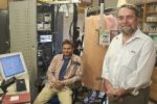(Press-News.org) COLUMBIA, Mo. ¬¬¬–Gold nanoparticles, tiny pieces of gold so small that they can't be seen by the naked eye, are used in electronics, healthcare products and as pharmaceuticals to fight cancer. Despite their positive uses, the process to make the nanoparticles requires dangerous and extremely toxic chemicals. While the nanotechnology industry is expected to produce large quantities of nanoparticles in the near future, researchers have been worried about the environmental impact of the global nanotechnological revolution.
Now, a study by a University of Missouri research team, led by MU scientist Kattesh Katti, curators' professor of radiology and physics in the School of Medicine and the College of Arts and Science, senior research scientist at the University of Missouri Research Reactor and director of the Cancer Nanotechnology Platform, has found a method that could replace nearly all of the toxic chemicals required to make gold nanoparticles. The missing ingredient can be found in nearly every kitchen's spice cabinet – cinnamon.
The usual method of creating gold nanoparticles utilizes harmful chemicals and acids that are not environmentally safe and contain toxic impurities. In the MU study, Katti and researchers Raghuraman Kannan, the Michael J and Sharon R. Bukstein Distinguished Faculty Scholar in Cancer Research, assistant professor of radiology and director of the Nanoparticle Production Core Facility; and Nripen Chanda, a research associate scientist, mixed gold salts with cinnamon and stirred the mixture in water to synthesize gold nanoparticles. The new process uses no electricity and utilizes no toxic agents.
"The procedure we have developed is non-toxic," Kannan said. "No chemicals are used in the generation of gold nanoparticles, except gold salts. It is a true 'green' process."
"From our work in green nanotechnology, it is clear that cinnamon — and other species such as herbs, leaves and seeds — will serve as a reservoir of phytochemicals and has the capability to convert metals into nanoparticles," Katti said. "Therefore, our approach to 'green' nanotechnology creates a renaissance symbolizing the indispensable role of Mother Nature in all future nanotechnological developments."
During the study, the researchers found that active chemicals in cinnamon are released when the nanoparticles are created. When these chemicals, known as phytochemicals, are combined with the gold nanoparticles, they can be used for cancer treatment. The phytochemicals can enter into cancer cells and assist in the destruction or imaging of cancer cells, Katti said.
"Our gold nanoparticles are not only ecologically and biologically benign, they also are biologically active against cancer cells," Katti said.
As the list of applications for nanotechnology grows in areas such as electronics, healthcare products and pharmaceuticals, the ecological implications of nanotechnology also grow. When considering the entire process from development to shipping to storage, creating gold nanoparticles with the current process can be incredibly harmful to the environment, Chanda said.
"On one hand, you are trying to create a new, useful technology. However, continuing to ignore the environmental effects is detrimental to the progress," Kannan said.
Katti, who is considered to be father of green nanotechnology, and Nobel prize winner Norman Borlaug have shared similar views on the potential of green nanotechnology in medicine, agricultural and life sciences. Borlaug predicted a connection between medical and agricultural sciences. Katti, who is the editor of The International Journal of Green Nanotechnology, said that as more uses for nanotechnology are created, scientists must develop ways to establish the connection between nanotechnology and green science. The study was published this fall in Pharmaceutical Research.
INFORMATION:
Cinnamon can replace harmful chemicals used to create nanoparticles
MU scientists make strides in green nanotechnology
2010-11-30
ELSE PRESS RELEASES FROM THIS DATE:
From the brain of a locust
2010-11-30
Tel Aviv - In the human brain, mechanical stress -- the amount of pressure applied to a particular area -- requires a delicate balance. Just the right force keeps neurons together and functioning as a system within the body, and proper nerve function is dependent on this tension.
Now researchers at Tel Aviv University say that mechanical stress plays an even more important role than medical science previously believed. Their research has the potential to tell us more than ever before about the form and function of neuronal systems, including the human brain. And they've ...
In Lancet: Artesunate suppositories are cost-effective intervention for severe childhood malaria
2010-11-30
Giving emergency artesunate suppositories to children with suspected severe malaria before referring them for treatment is a cost-effective intervention that can substantially improve the management of childhood malaria in remote African settings, according to a new study led by Boston University School of Public Health [BUSPH] researcher Yesim Tozan, PhD, (link to profile: http://sph.bu.edu/tozan)
The study, which appears online Nov. 29 in The Lancet , builds on previous research that found that the administration of one dose of rectal artesunate by a community health ...
Blast from the past: Jack pine genetics support a coastal glacial refugium
2010-11-30
Can a road-trip across eastern North America, ancient ice sheets, and DNA samples unlock the ancestral history of jack pine trees? Julie Godbout and colleagues from the Université Laval, Quebec, Canada, certainly hoped that driving across northeastern U.S. and Canada to collect samples from jack pine trees would shed some light on how glaciers may have impacted present-day pine genetics.
About 20,000 years ago, ice sheets covered most of the northern terrestrial surface of the continent of North America. For some boreal species this Last Glacial Maximum period may ...
A 'USB' for medical diagnosis?
2010-11-30
Biomedical engineers at UC Davis have developed a plug-in interface for the microfluidic chips that will form the basis of the next generation of compact medical devices. They hope that the "fit to flow" interface will become as ubiquitous as the USB interface for computer peripherals.
UC Davis filed a provisional patent on the invention Nov. 1. A paper describing the devices was published online Nov. 25 by the journal Lab on a Chip.
"We think there is a huge need for an interface to bridge microfluidics to electronic devices," said Tingrui Pan, assistant professor ...
Tempest in a teapot: International team of scientists describes swirling natural phenomena
2010-11-30
(Santa Barbara, Calif.) –– Scientists can use cylinders as small as teapots to study the mechanisms involved in powerful hurricanes and other swirling natural phenomena.
The earth's atmosphere and its molten outer core have one thing in common: Both contain powerful, swirling vortices. While in the atmosphere these vortices include cyclones and hurricanes, in the outer core they are essential for the formation of the earth's magnetic field. These phenomena in earth's interior and its atmosphere are both governed by the same natural mechanisms, according to experimental ...
Hormone oxytocin bolsters childhood memories of mom's affections
2010-11-30
Researchers have found that the naturally-occurring hormone and neurotransmitter oxytocin intensifies men's memories of their mother's affections during childhood. The study was published today in Proceedings of the National Academy of Sciences.
Researchers at the Seaver Autism Center for Research and Treatment at Mount Sinai School of Medicine wanted to determine whether oxytocin, a hormone and neurotransmitter that is known to regulate attachment and social memory in animals, is also involved in human attachment memories. They conducted a randomized, double-blind, ...
Caffeinated alcoholic beverages -- a growing public health problem
2010-11-30
San Diego, CA, November 30, 2010 – In the wake of multiple state bans on caffeinated alcoholic beverages (CABs) and an FDA warning to four companies to remove their products from the marketplace, an article published online today in the American Journal of Preventive Medicine delineates the scope of the public health problem and suggests areas of research that might help address it.
"Although several manufacturers of caffeinated beer have withdrawn their products from the market, there is no sign that young people have decreased the practice of combining alcohol and energy ...
Neuroscience of instinct: How animals overcome fear to obtain food
2010-11-30
When crossing a street, we look to the left and right for cars and stay put on the sidewalk if we see a car close enough and traveling fast enough to hit us before we're able to reach the other side. It's an almost automatic decision, as though we instinctively know how to keep ourselves safe.
Now neuroscientists have found that other animals are capable of making similar instinctive safety decisions. In a study published online the week of Nov. 29 in the Proceedings of the National Academy of Sciences, University of Washington researcher Jeansok Kim demonstrates that ...
Motivation to end racism relies on 'yes we can' approach
2010-11-30
If you're trying to end racism, it's not enough to get people to understand that racism is still a problem. You also have to make them feel like they can do something about it, according to a new study published in Psychological Science, a journal of the Association for Psychological Science.
Tracie L. Stewart of Georgia State University was inspired to conduct the study by work she's done on evaluating a popular diversity training program. She found that the program reduced many white participants' bias in the short term, which was good. "But some white participants ...
Abnormal blood vessel function found in women with broken heart syndrome
2010-11-30
ROCHESTER, Minn. - A team of Mayo Clinic researchers has found that patients with broken heart syndrome, also known as apical ballooning syndrome (ABS), have blood vessels that don't react normally to stress. These results offer clues to the cause of this rare syndrome and may help with efforts to identify patients who are more vulnerable to mental stress so that appropriate therapies can be developed. The study is published online in the Journal of the American College of Cardiology.
Apical ballooning syndrome affects mainly postmenopausal women, and a few men. The symptoms ...
LAST 30 PRESS RELEASES:
Crystallographic engineering enables fast low‑temperature ion transport of TiNb2O7 for cold‑region lithium‑ion batteries
Ultrafast sulfur redox dynamics enabled by a PPy@N‑TiO2 Z‑scheme heterojunction photoelectrode for photo‑assisted lithium–sulfur batteries
Optimized biochar use could cut China’s cropland nitrous oxide emissions by up to half
Neural progesterone receptors link ovulation and sexual receptivity in medaka
A new Japanese study investigates how tariff policies influence long-run economic growth
Mental trauma succeeds 1 in 7 dog related injuries, claims data suggest
Breastfeeding may lower mums’ later life depression/anxiety risks for up to 10 years after pregnancy
Study finds more than a quarter of adults worldwide could benefit from GLP-1 medications for weight loss
Hobbies don’t just improve personal lives, they can boost workplace creativity too
Study shows federal safety metric inappropriately penalizes hospitals for lifesaving stroke procedures
Improving sleep isn’t enough: researchers highlight daytime function as key to assessing insomnia treatments
Rice Brain Institute awards first seed grants to jump-start collaborative brain health research
Personalizing cancer treatments significantly improve outcome success
UW researchers analyzed which anthologized writers and books get checked out the most from Seattle Public Library
Study finds food waste compost less effective than potting mix alone
UCLA receives $7.3 million for wide-ranging cannabis research
Why this little-known birth control option deserves more attention
Johns Hopkins-led team creates first map of nerve circuitry in bone, identifies key signals for bone repair
UC Irvine astronomers spot largest known stream of super-heated gas in the universe
Research shows how immune system reacts to pig kidney transplants in living patients
Dark stars could help solve three pressing puzzles of the high-redshift universe
Manganese gets its moment as a potential fuel cell catalyst
“Gifted word learner” dogs can pick up new words by overhearing their owners’ talk
More data, more sharing can help avoid misinterpreting “smoking gun” signals in topological physics
An illegal fentanyl supply shock may have contributed to a dramatic decline in deaths
Some dogs can learn new words by eavesdropping on their owners
Scientists trace facial gestures back to their source. before a smile appears, the brain has already decided
Is “Smoking Gun” evidence enough to prove scientific discovery?
Scientists find microbes enhance the benefits of trees by removing greenhouse gases
KAIST-Yonsei team identifies origin cells for malignant brain tumor common in young adults
[Press-News.org] Cinnamon can replace harmful chemicals used to create nanoparticlesMU scientists make strides in green nanotechnology




